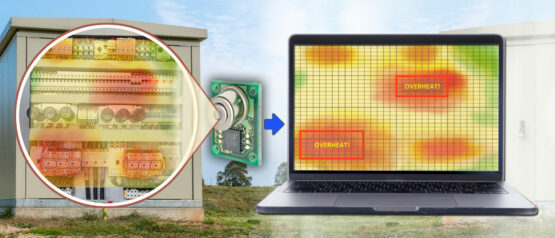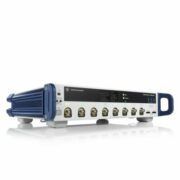To operate reliably and safely in remote locations, industrial automation systems and other electrical installations need their thermal status to be fully and constantly monitored.
An abnormal increase in temperature is frequently an early indication of a fault condition and needs to be addressed before the system is damaged or worse still, combusts.
Increases can take the form of individual ‘hot spots’ where parts of a panel or individual components are operating close to or above a safe temperature and rises in the ambient temperature. The first can be due to a fault condition, such as a short circuit, or by a component such as a transformer running at peak load for lengthy periods. The second can be caused by the operating environment (prolonged exposure to intense sunlight), or a failure of cooling components such as fans. Both are a threat.
Maintenance by IoT
The goal of maintenance over the Internet of Things (IoT) is always to ensure “zero down time” and eliminate unforeseen device failures that can lead to serious accidents or unplanned facility stops.
To achieve this, the temperature of every panel in a plant as well as the surrounding ambient temperature needs to be monitored continuously using appropriate sensor solutions. Real-time remote monitoring in this way ensures that the need for site visits is kept to an absolute minimum. Sometimes the fault can be rectified remotely, perhaps by reducing power demand from the system to allow key components to cool. Other times an engineer site visit is needed, for example to replace a faulty component or to repair a short circuit.
Monitoring of the temperature of the whole cabinet in which the system is housed is essential but by itself clearly insufficient: a component can be running dangerously hot and be in danger of meltdown or combustion without affecting the overall temperature of the system. On the other hand, attaching an individual temperature sensor to each electrical component is completely impractical – a wiring loom for example can develop hotspots almost anywhere. New wide-angle thermal image sensors that can detect hotspots in large areas of a system such as a whole panel, provide a great starting point for the truly effective remote thermal management of electrical systems. Complemented by ambient temperature sensors and air velocity sensors to verify the correct operation of cooling fans, they can provide a complete IoT based thermal monitoring and remote maintenance solution.
Wide-angle thermal sensors
New infrared thermal sensors with a wide viewing angle in a compact body highlight hotspots anywhere in their field of view, filling the gap between taking an ‘average’ value of the temperature of the whole system and taking a reading of the temperature at one or two selected points (Figure 1).
Omron D6T MEMS thermal (IR) sensors measure the surface temperature of objects without touching them using a thermopile element that absorbs radiated energy from the target object. Incorporating a state-of-the-art MEMS thermopile, custom designed sensor ASIC and signal processing microprocessor and algorithm into tiny package, the D6T is believed to offer the highest signal-to-noise ratio (SNR) in the industry. This ensures clear, reliable measurements that can readily be interpreted by the system. A key advantage of the integrated signal processing microprocessor is the fully linear output (figure 2). By pre-processing the signal on the module, the D6T converts the sensor signal to a digital temperature output giving a straightforward interface to a microcontroller, simplifying the system integrator’s task. Alternative devices do not provide a temperature output, so the designer needs to implement a signal processing algorithm to convert the output to temperature.
The space saving design of the D6T, at only 14 x 8 x 8.93 mm for the largest 32 x 32 element version, makes it exceptionally well suited for installation in a panel or system. Its field of view of 90.0° by 90.0° encompasses an area of 200cm x 200cm from 1 meter distance, providing contactless measurement of temperatures of 0-200ºC in ambient temperatures of -10-70ºC. For smaller systems requiring a more restricted field of view, a suitable alternative is the 1×8 D6T-8L-09H or the 4×4 D6T-44L-06H, offering 54.5° x 5.5° and 44.2° by 45.7° respectively. At 1 meter distance; the field of view of these devices is 10cm x 103cm and 81cm x 84cm respectively. There is also the single element Omron D6T-1A-02 which has a viewing angle of just 26.5° x 26.5° translating to an area of 47x47cm at a distance of 1 meter, giving a highly directional characteristic.
Ambient temperature
Whilst these sensors will identify specific hot spots, there remains a need to monitor the ambient temperature of the system as a whole. A high ambient temperature can be the reason why parts of the system are threatening to overheat and can by itself cause it to malfunction. Compact multi-purpose environmental sensors make it very easy for the designer to deliver a wide range of measurement functions including temperature, humidity, air quality, light, barometric pressure, noise and acceleration from just one small sensor. Sensors like the Omron 2JCIE (Figure 3) provide the capability to monitor all of these and provides data via popular wireless and wired data interfaces like Bluetooth and USB. Despite its compact size, 2JCIE features its own embedded memory for data logging to keep track of the surroundings.
Monitoring of cooling systems
Increases in ambient temperature can, of course, be caused by degradation or even failure of the cooling systems such as fans. These need to be maintained, like every other component and monitored continuously in real time to ensure that their performance has not dropped below the required level due to wear or to a buildup of dirt in the airway.
Suitable sensors are available to help with this task. Omron’s D6F-PH digital pressure sensors (Figure 4) for air flow and clogged filter detection in heat recovery units do this by detecting the differential pressure upstream and downstream of the fan or filter, detecting the degradation in performance as it becomes clogged with dirt and providing an alert when cleaning or replacement is required. A more compact alternative is the 2SMPB barometric pressure sensor. The Omron D-6FV can improve efficiency by monitoring the exact air rate at which air is extracted by the fans.
Conclusion
Maintenance engineers should be able to carefully monitor the thermal status of a panel in real time without needing to open the panel door. A combination of the three types of sensors described in this article fully achieves this goal. Wide angle IR sensors identify hot spots wherever they occur on a panel; ambient temperature sensors monitor the overall temperature of the cabinet while air flow sensors verify that the cooling fans are operating correctly. The real-time output of these sensor solutions can then be analysed with algorithms, deskilling the maintenance process and allowing personnel to identify a fault and react in real time. By tracking temperature changes over time, predictions can be made allowing maintenance to be scheduled to maximise engineer productivity and minimise downtime.










